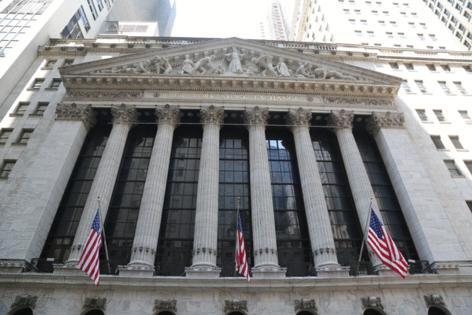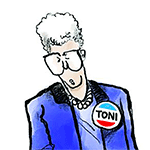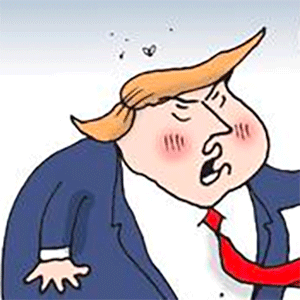Stocks and bonds climb after week of upheaval: Markets wrap
Published in News & Features
A degree of calm returned to Wall Street, with stocks and bonds notching a twin rally after a tumultuous week in the grip of President Donald Trump’s disruptive trade war.
With the White House signaling a tariff reprieve on key consumer electronics, the S&P 500 gained almost 1%. Apple Inc. extended a two-day surge to more than 6% to lead gains in megacaps. Carmakers rallied as Trump floated exceptions for auto parts facing 25% U.S. levies. Treasuries snapped a five-day slide that drove 10-year yields up by the most in over two decades.
To Matt Maley at Miller Tabak, investors are starting to conclude there are now at least some boundaries to how aggressive the administration can be with its proposals.
“If the rebound is going to have legs in the near term, investors will probably need to see continued signs of flexibility from the White House on tariffs,” said Chris Larkin at E*Trade from Morgan Stanley. “Uncertainty is still high, and day-to-day volatility could remain elevated.”
Investors are still struggling to game out the economic spillovers of the trade war given the back-and-forth in negotiations. While U.S. officials insist the tariff strategy is carefully constructed, critics see the trading order as subject to the whims of a transactional president.
The biggest Wall Street firms have highlighted how difficult it has been to predict the trajectory for equities. Barclays Plc’s Venu Krishna said the recent volatility leaves little confidence in any pricing now, while JPMorgan Chase & Co.’s Dubravko Lakos-Bujas indicated that forecasting in the current environment is a challenge and leaves a wide range of outcomes.
“As we begin this week, again, traders will be fixated to social media feeds and the newswires for the latest on this never ending saga of ‘tariffs-on, tariffs-off’,” said Jay Woods at Freedom Capital Markets. “One thing the current administration has been great at is keeping market participants on their toes.”
Strategists at BlackRock Inc.’s research arm said they are dialing up their risk-taking and embracing U.S. and Japanese stocks following the Trump administration’s pause of tariffs on many global trading partners, even as they steer clear of longer-dated U.S. debt.
“The near-term risk of a financial accident has eased,” wrote the BlackRock Investment Institute strategists including Jean Boivin and Wei Li. “Checks on policy allowed us to extend our tactical horizon back to six to 12 months and resume our positive view on U.S. and Japanese stocks”
Meantime, Citigroup Inc. strategists led by Beata Manthey lowered their view on U.S. equities, saying the case to diversify away from the asset class is strengthening as the trade war undermines economic growth and earnings.
“The worst may be over, but the coast is not clear,” said Michael Wilson at Morgan Stanley. “The 90-day pause on reciprocal tariffs and further concessions over the weekend lessen the near-term probability of a recession, but uncertainty remains high, the Fed is on hold and back-end rates are a headwind.”
Despite all the convulsions and uncertainty, most equities strategists still expect the S&P 500 to rally through the remainder of 2025.
The S&P 500 put up a strong performance last week, but is still down for the year as Trump has placed substantial tariffs on goods imported from China, Canada, Mexico, the EU and numerous other U.S. trade partners. The benchmark closed trading on Tuesday having lost 15% in 2025, before reversing course on Thursday when Trump announced a 90-day delay on many of his tariffs.
The 15% drop is historically significant. Going back to 1957, the S&P 500 has fallen at least that much through early April 16 times, and on only three occasions has it recovered to end December in the green, according to data compiled by Ryan Detrick at Carson Group LLC. And in each of those instances — 2020, 2009 and 1982 — the market was rescued by the Federal Reserve, which stepped in to support a faltering U.S. economy.
“Last week’s moves were so violent that we may be nearing capitulation,” said Callie Cox at Ritholtz Wealth Management. “The point where expectations are so low that any kind of positive news brings massive relief. Fear is a good thing, and when fear is abundant, it’s probably fair to say we’re closer to the bottom than the top. But is this true today?”
Cox says that based on the conditions we’re facing, there may be more selling ahead.
In corporate news, Goldman Sachs Group Inc. became the latest firm to report its highest-ever quarter for equity trading, after JPMorgan Chase & Co. and Morgan Stanley hit similar milestones last week amid
The intense market swings create the opportunity to make profit but traders also run the risks of higher losses. In market parlance, periods when investors capitalize on volatility is called ‘good volatility’ while it’s deemed ‘bad’ if they sit it out, potentially crippling liquidity.
Apple’s iPhone unit shipments surged 10% in the first quarter, according to IDC. Mark Zuckerberg took the stand in federal court as the first witness in the U.S. Federal Trade Commission’s antitrust trial seeking to break up Meta Platforms Inc. Nvidia plans to produce up to $500 billion of AI gear in the U.S. Intel Corp. agreed to sell a 51% stake in its programmable chips unit Altera.
Treasuries may have hit the bottom for now amid signs of robust foreign demand and expectations for the Federal Reserve to support U.S. government debt when needed, according to JPMorgan Asset Management.
“I feel pretty good that we’re putting in a low in price and a high in yield here,” Bob Michele, the firm’s global head of fixed income, said in a joint interview on Bloomberg Television. “In our conversations with overseas investors, they’re not being shaken out of Treasuries.”
Michele cited Fed data showing foreign central banks and reserve managers recently boosted their holdings of Treasuries.
Policymakers are closely monitoring a variety of similar gauges to assess whether Trump’s sweeping tariffs will result in more persistent price growth. While many economists forecast the duties to boost inflation — at least in the near-term — tariff threats so far haven’t changed consumers’ views over the long term.
Fed Governor Christopher Waller laid out two scenarios for how Trump’s trade policy could affect the U.S. economy, but said the inflationary impact of either would likely be temporary.
Waller called the new tariff policy “one of the biggest shocks to affect the U.S. economy in many decades,” in remarks prepared for an event in St. Louis on Monday. Should there be a small tariff effect on inflation, rate cuts would “very much” be on the table for the latter half of 2025, he said.
Some of the main moves in markets:
Stocks
—The S&P 500 rose 0.8% as of 4 p.m. New York time
—The Nasdaq 100 rose 0.6%
—The Dow Jones Industrial Average rose 0.8%
—The MSCI World Index rose 1.3%
—Bloomberg Magnificent 7 Total Return Index was little changed
—The Russell 2000 Index rose 1.1%
Currencies
—The Bloomberg Dollar Spot Index fell 0.3%
—The euro was unchanged at $1.1355
—The British pound rose 0.8% to $1.3190
—The Japanese yen rose 0.3% to 143.06 per dollar
Cryptocurrencies
—Bitcoin rose 1.7% to $84,883.51
—Ether rose 2.8% to $1,635.16
Bonds
—The yield on 10-year Treasuries declined 12 basis points to 4.37%
—Germany’s 10-year yield declined six basis points to 2.51%
—Britain’s 10-year yield declined nine basis points to 4.66%
Commodities
—West Texas Intermediate crude rose 0.2% to $61.62 a barrel
—Spot gold fell 0.8% to $3,212.94 an ounce
(With assistance from John Viljoen, Sujata Rao, Anand Krishnamoorthy and Matthew Burgess.)
©2025 Bloomberg L.P. Visit bloomberg.com. Distributed by Tribune Content Agency, LLC.







Comments